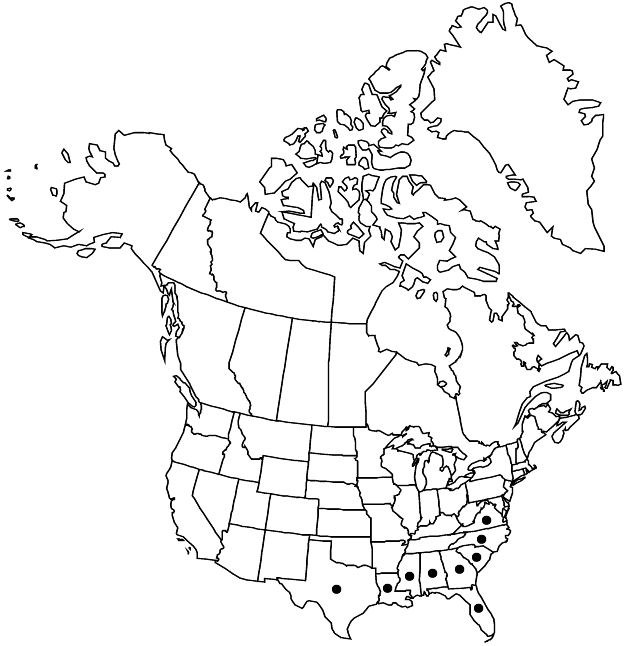Difference between revisions of "Hypericum setosum"
Sp. Pl. 2: 787. 1753.
FNA>Volume Importer |
FNA>Volume Importer |
||
| Line 15: | Line 15: | ||
|name=Ascyrum villosum | |name=Ascyrum villosum | ||
|authority=Linnaeus | |authority=Linnaeus | ||
| − | }}{{Treatment/ID/Synonym | + | }} {{Treatment/ID/Synonym |
|name=Brathys tomentosa | |name=Brathys tomentosa | ||
|authority=Spach | |authority=Spach | ||
| − | }}{{Treatment/ID/Synonym | + | }} {{Treatment/ID/Synonym |
|name=Hypericum pilosum | |name=Hypericum pilosum | ||
|authority=Walter | |authority=Walter | ||
| − | }}{{Treatment/ID/Synonym | + | }} {{Treatment/ID/Synonym |
|name=H. villosum | |name=H. villosum | ||
|authority=(Linnaeus) Crantz | |authority=(Linnaeus) Crantz | ||
| Line 39: | Line 39: | ||
|elevation=0–200 m | |elevation=0–200 m | ||
|distribution=Ala.;Fla.;Ga.;La.;Miss.;N.C.;S.C.;Tex.;Va. | |distribution=Ala.;Fla.;Ga.;La.;Miss.;N.C.;S.C.;Tex.;Va. | ||
| − | |discussion=<p>Hypericum setosum is the only American Hypericum sp. with an indumentum. It is related to H. virgatum (H. denticulatum subsp. acutifolium); in addition to having the indumentum, it is generally smaller and less branched and has a different chromosome number.</p> | + | |discussion=<p><i>Hypericum setosum</i> is the only American <i>Hypericum</i> sp. with an indumentum. It is related to <i>H. virgatum</i> (<i>H. denticulatum</i> subsp. acutifolium); in addition to having the indumentum, it is generally smaller and less branched and has a different chromosome number.</p> |
|tables= | |tables= | ||
|references= | |references= | ||
| Line 63: | Line 63: | ||
|publication year=1753 | |publication year=1753 | ||
|special status=Endemic | |special status=Endemic | ||
| − | |source xml=https://jpend@bitbucket.org/aafc-mbb/fna-data-curation.git/src/ | + | |source xml=https://jpend@bitbucket.org/aafc-mbb/fna-data-curation.git/src/8f726806613d60c220dc4493de13607dd3150896/coarse_grained_fna_xml/V6/V6_153.xml |
|genus=Hypericum | |genus=Hypericum | ||
|section=Hypericum sect. Brathys | |section=Hypericum sect. Brathys | ||
Revision as of 17:46, 18 September 2019
Herbs annual or perennial, erect, usually unbranched proximal to inflorescence, 2–8 dm. Stems: internodes 4-lined, scabrous-tomentose to pilose. Leaves appressed to ascending, sessile; blade narrowly ovate or lanceolate to narrowly oblong-elliptic (or proximal oblanceolate), 4–15 × 1.5–7 mm, subcoriaceous, margins recurved, apex acute to obtuse, surfaces scabrous-tomentose to pilose, basal veins 1(–5), midrib with 0–1 pair of branches. Inflorescences cylindric to subcorymbiform, to 30-flowered, branching mostly dichasial. Flowers 5–11 mm diam.; sepals ovate to ovate-lanceolate or obovate, subequal, 2.5–5 × 1.5–2.5 mm, margins setulose-ciliate, apex acute; petals 5, deep yellow, obovate, 4–7 mm; stamens (15–)20–40, filaments almost distinct; styles 1.5–2 mm; stigmas ± broadly capitate. Capsules ovoid to ellipsoid-subglobose, 3.5–5 × 2–3 mm. Seeds 0.4–0.6 mm; testa linear-reticulate. 2n = 12.
Phenology: Flowering early–late summer (Jun–Sep).
Habitat: Wet ditches, bogs, savannas, wet pinelands on sandy soil
Elevation: 0–200 m
Distribution

Ala., Fla., Ga., La., Miss., N.C., S.C., Tex., Va.
Discussion
Hypericum setosum is the only American Hypericum sp. with an indumentum. It is related to H. virgatum (H. denticulatum subsp. acutifolium); in addition to having the indumentum, it is generally smaller and less branched and has a different chromosome number.
Selected References
None.